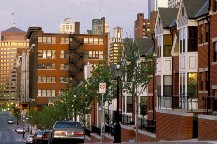| housing diversity: overview » introduction » as-of-right development |
"as of right." Developers still need to secure a building permit and fulfill customary regulatory requirements, but the approvals process is generally less contentious and/or |  Photo courtesy of McCormack Baron Salazar |
Accessory dwelling units within or attached to a larger single-family home, or on the same lot. Mixed-use housing, where residential units co-exist with commercial and retail enterprises. Single-room occupancies, also called efficiency apartments and residential studio units. |
| You are currently reading: Revise zoning policies to allow development of a range of housing types "as of right" Greater housing diversity and affordability may be achieved by revising zoning policies to eliminate both direct and "back door" prohibitions and explicitly allow a range of housing types, rather than requiring a special review process or disallowing certain types of structures entirely. Other pages in this section:  Consider other innovative land use regulations that facilitate delivery of lower-cost homes Consider other innovative land use regulations that facilitate delivery of lower-cost homesLocal officials can implement an array of land use tools to create a regulatory environment that is hospitable to the development of homes affordable to working families Click here to view other resources on zoning policies that allow housing diversity. |